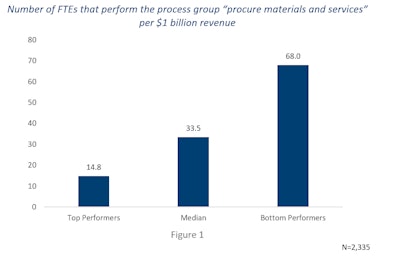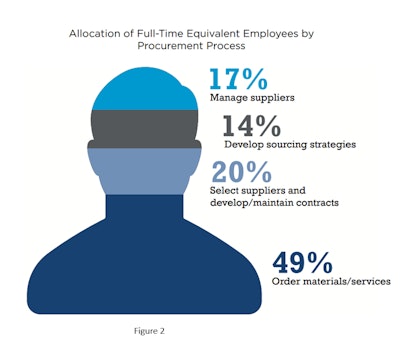
Although procurement has at times been viewed narrowly in terms of only purchasing materials and services, APQC applies a much broader, process-based view. This broader view of procurement, which does include purchasing, is a mix of strategic as well as tactical processes. As defined in APQC's Process Classification Framework®, the procurement process group includes: providing sourcing governance and performing category management, developing sourcing and category management strategies, selecting suppliers, developing and maintaining contracts, ordering materials and services, and managing suppliers. Given the critical role procurement plays in an organization, it’s important to keep an eye on the total number of full-time equivalent employees (FTEs) focused on this group of processes.
As illustrated in Figure 1, data from APQC’s Open Standards Benchmarking in procurement shows the wide range of FTEs for the procurement process group across industries. Top performers, e.g., organizations at the 25th percentile, have fewer than 15 FTEs in procurement per $1 billion in revenue. By comparison, at the 75th percentile, organizations report more than 4.5 times as many procurement FTEs.

An important consideration for this efficiency measure is not just the number of FTEs in procurement, but how those FTEs are deployed (Figure 2). Tactically processing purchase orders has been a labor-intensive process. As such, many leading organizations have turned to technology, such as e-procurement, to increase productivity and reduce the number of FTEs required for that process. Organizations are using e-procurement to buy both direct and indirect materials, to leverage volume discounts, consolidate buying, and decrease labor costs.

Standardizing procurement processes increases performance by eliminating process overlaps and enhances effectiveness by reducing complexities through enterprise-wide standards. Once that occurs, e-procurement and other smart systems can automate non-value-added tasks, allowing organizations to shift employees’ focus to more strategic processes such as developing sourcing strategies, appraising suppliers, or developing collaborative relationships with suppliers.
Calculation
This measure is calculated by dividing the number of FTEs who perform the process group “procure materials and services” by the total business entity revenue (multiplied by * .000000001).
To calculate FTEs involved in this process group, assume that a full-time employee represents 40 hours per week, and calculate the percentage of that employee’s time allocated to this particular process group. For example, if an employee spends only 25 percent of his or her time in procurement, that would equal 0.25 FTE allocated to that process group.












